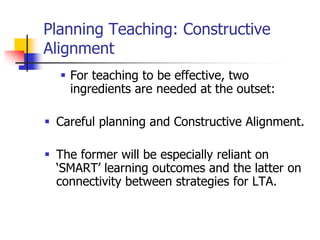
Planning Teaching: Constructive Alignment (CA
- 1. Planning Teaching: Constructive Alignment For teaching to be effective, two ingredients are needed at the outset: Careful planning and Constructive Alignment. The former will be especially reliant on ‘SMART’ learning outcomes and the latter on connectivity between strategies for LTA.
- 2. Constructive Alignment ‘A good teaching system aligns teaching method and assessment to the learning activities stated in the objectives so that all aspects of this system are IN ACCORD in supporting appropriate student learning’. (Seigel, 2004) See following diagram:
- 3. Constructive alignment: the “golden triangle” Learning Outcomes Teaching and Learning Activity Assessment
- 4. Definition: ‘Learning outcomes are statements of what is expected that the student will be able to do as a result of a learning activity’ (Jenkins and Unwin, 2001). ‘Learning outcomes are an explicit description of what a learner should know, understand and be able to do as a result of learning’ (Bingham, 1999)
- 5. Purposes: • Clear expectations are set for students • Teaching has a specific focus • Appropriate matching strategies for teaching and assessment are chosen • Helps to keep teaching focused on student learning • Student-centred learning is developed
- 6. Learning Outcomes should be ‘SMART’ Specific Measurable Achievable Realistic Timed These have major implications for planning. However….
- 7. Using a Framework Learning outcomes can NOT be written in a vacuum. A framework is needed within which to develop them. Bloom’s Taxonomy of Educational Objectives provides this. It is depicted diagrammatically thus:
- 8. Linking learning outcomes to levels Hierarchy of learning e.g. Bloom’s six categories of cognitive learning: knowledge comprehension application analysis synthesis evaluation Higher learning levels
- 9. Knowledge Understanding Evaluation Analysis Application Synthesis Bloom’s Taxonomy of Educational Objectives (1956)
- 10. Bloom’s Levels Cognitive Domain 6. Evaluation Making judgement about value against criteria of what has been learnt. 5. Synthesis Combining together to make a coherent whole. Involves logical deduction, creativity, discovery of patterns, structure. 4. Analysis Breaking into component parts, listing elements, establishing the relationship between them. One infers, compares, contrasts and categorises. 3. Application Using something in a specific manner, experimenting, practising, testing. Applying general principles or theory to practice.
- 11. Bloom continued 2. Comprehension Grasping meaning, assimilating, communicating in one’s own words. 1. Knowledge Recall of factual information, being able to remember, label or recognise something. Follow up: examine with a colleague the learning outcomes for one of your modules. ●At which levels of the Taxonomy are they located? ●Are your action words found in the handout given? ●Is there alignment with the assessment strategies?
- 12. Other Essentials of Planning Decisions about: How previous content will be built on: high selectivity KEY topics or points (Land’s ‘threshold concepts’) How much time to allocate to each Strategies for learning (PAR and BEM) Key questions that will be asked How explanations will be structured How stimulus variation will be employed How student attention will be optimised What will make the learning inclusive Types of learners (multi-sensory teaching)
- 13. ‘PAR’ and ‘BEM’ Present, Apply, Review (PAR) Beginning, End and Middle Principle (BEM) The BEM (beginning – end – middle) principle states that the beginnings and endings of presented content are more readily remembered than content in the middle. (The Primacy Effect) Thus, the first 10-12 minutes and the last 8-10 minutes of a presentation (The Recency Effect) are optimum periods for learning. What are the implications of this?
- 14. The ‘PAR’ Model (Petty) Present content Apply content Review content Associated skills are: Set Induction and Closure (P) Effective Questioning/active learning (A) Effective assessment strategies (R)
- 15. ‘Well begun is half done’ Set Induction and Closure: Cognitive Set: an overview of learning Perceptual Set: how one is perceived Social Set: creating a social environment for learning Motivational Set: this is worth doing Cognitive, social and motivational closure Examples of strategies for cognitive set are: Advanced organisers, concept maps, ‘fishbones’
- 16. CLOSURE This takes two forms: Transitional closure Summative closure Making each student-centred is crucial to successful learning and teaching. Closure ensures that learning is formatively assessed. It should be undertaken by students It should be explicit and carefully integrated.
- 17. SCL has occurred when: Students realise that their learning is incomplete They have engaged in self-assessment facilitated by their tutors They make decisions about moving forward, accepting personal responsibility for learning They are beginning to bridge the gap between surface and deep learning
- 18. Self-Assessment What resources are needed to complete this? How much do I already know? What do I still need to find out? Can this be prioritised? What will help fill gaps? What is my action plan/time plan? How might I build on/IMPROVE previous work? Why is this topic important? What links are there between theory and practice?
- 19. Surface Learning encouraged by: Recall rather than application and analysis etc. Anxiety creating assessments (too many/too difficult) Poorly timed assessments: end-loading Excessive amounts of material/absence of ‘threshold concepts’ Poor or absent feedback/formative feedback Lack of independence in studying/ no peer learning Lack of interest in and background knowledge of subject matter Previous experiences of educational settings that encourage these approaches Few, if any, opportunities for self-assessment
- 20. Deep Learning is fostered by: Active and long-term engagement with tasks Self-assessment of learning Stimulating and considerate teaching through which relevance and meaning are clarified and emphasised Clearly stated academic expectations Opportunities to exercise reasonable choice in the method and content of study Interest in and background knowledge of the subject matter Previous experiences of educational settings that encourage these approaches (See: Ramsden, P (1992), Learning to Teach in Higher Education’)
